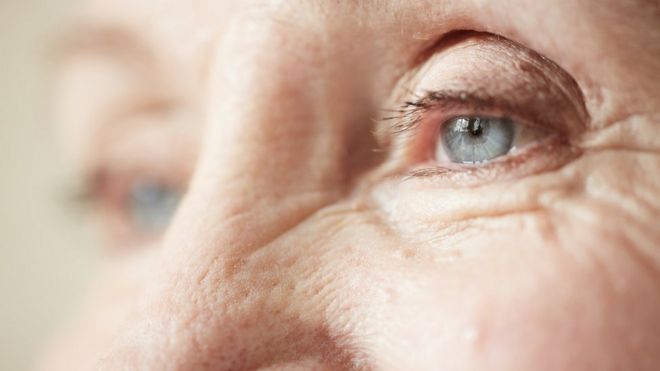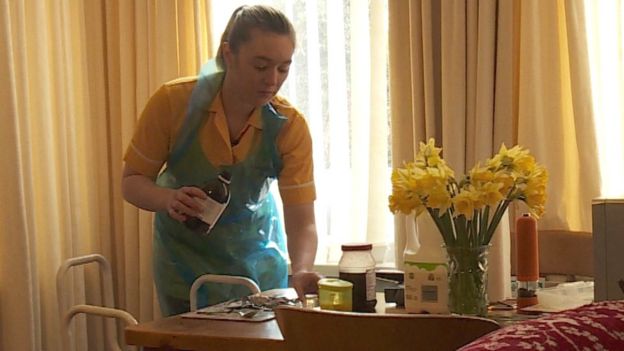About 700,000 eggs have been sent to the UK from potentially contaminated Dutch farms, up from an early estimate of 21,000, the food watchdog has said.
The Food Standards Agency (FSA) said it was very unlikely that there was a risk to public health.However, 11 products containing egg - including sandwiches and salads - have been withdrawn from supermarkets.
Dutch police have now arrested two people suspected of using the insecticide fipronil.
The FSA said the 700,000 figure represented 0.007% of eggs eaten in the UK each year.
What do we know about the Europe egg scare?
It added that in the UK, the Dutch eggs were not sold as shell eggs but used in foods with many other ingredients - mostly sandwich fillings or other chilled foods.
It said traces of fipronil - which can be harmful to humans - were mixed with other eggs so chemical residues would be "highly diluted".
The British Egg Industry Council said shell eggs on sale to consumers in the UK were not affected.
It said: "All major UK retailers stock British Lion shell eggs and tests have shown that there is no risk from British eggs."
Withdrawn egg products
- Sainsbury's ham and egg salad (240g) use by 9-14 August 2017
- Sainsbury's potato and egg salad (300g) use by 9-14 August
- Morrisons potato and egg salad (250g) use by up to 13 August
- Morrisons egg and cress sandwich (sold in Morrisons Cafe only) use by up to and including 11 August
- Morrisons cafe sandwich selection (sold in Morrisons Cafe only) use by up to and including 11 August
- Waitrose free range egg mayonnaise deli filler (240g) use by 13 and 16 August
- Waitrose free range reduced fat egg mayonnaise deli filler (170g) use by 14 August
- Waitrose free range egg and bacon deli filler (170g) use by 14 and 16 August
- Asda baby potato and free range egg salad (270g) use by 9, 10, 11, 12, 13 and 14 August
- Asda spinach and free range egg snack pot (110g) use by 9, 10, 11, 12 and 13 August
- Asda FTG ham and cheddar ploughman's salad bowl (320g) use by 9, 10, 11, 12 and 13 August
Scandal 'isn't over'
Twenty tonnes of insecticide-tainted eggs have been sold in Denmark, the country's food safety authority says.Denmark is believed to be the tenth country to be affected, with Romania and Luxembourg among the latest to report finding contaminated products.
Supermarkets in Belgium, the Netherlands and Germany have withdrawn millions of eggs from sale.
In the UK, processed foods containing eggs, including sandwiches and salads, have been recalled from Sainsbury's, Morrisons, Waitrose and Asda.
The FSA initially thought far fewer eggs - 21,000 - had been distributed to the UK from implicated farms between March and June this year.
Prof Chris Elliott, of the Institute for Global Food Security at Queen's University Belfast, said it was not surprising that the figure had increased by so much - and warned "the scandal isn't over yet".
"Often when these food scandals start to break, you start to get dribbles of information," he told BBC Radio 4's PM programme.
"And as the authorities in Belgium and Holland get more information they pass that onto our own Food Standards Agency.
"The potential is that number of 700,000 could increase quite a bit yet," he added.
Should I stop eating eggs?
 Image copyright AFP
Image copyright AFP Fipronil should not be allowed anywhere near food.
But the risk from eggs is thought to be low, because the number of contaminated eggs is also low.
While 700,000 eggs sounds like a lot, it is worth remembering we eat 34 million every single day in the UK.
It is why the Food Standards Agency says it is "very unlikely" there is any health risk.
Many of the affected eggs will have already passed through the food chain before anyone was aware of the scandal.
And the FSA has now pulled egg sandwiches and egg salads off the shelves that were made while contaminated eggs were still being imported.
It insisted there is "no need" for people to stop eating eggs.
Fipronil, which is used to kill lice and ticks on animals, can damage people's kidneys, liver and thyroid glands if eaten in large quantities.
Heather Hancock, FSA chairwoman, said it was not "something to worry about" and that any health impact was unlikely.
"These aren't eggs that are in people's fridges in the UK, these are eggs that have gone into the food chain and the level of risk to public health is very low," she told BBC Radio 4's World at One programme.
Media playback is unsupported on your device
How safe are Dutch eggs to eat?
The FSA said decision to withdraw the products was not due to food safety concerns but based on the fact that the pesticide is not authorised for use in food-producing animals.
It added: "While in some European countries eggs containing fipronil residues have been sold as fresh eggs, in the UK this is not the case."
Aldi and Lidl stores in Germany are among the supermarkets to remove eggs from their shelves, in a move Aldi described as "purely precautionary". Eggs sold in its UK stores were British, Aldi said.
It follows a joint investigation by Dutch and Belgian police of several premises thought to be using the substance, which can harm humans and is banned in food production.
The Netherlands is Europe's biggest egg producer - and one of the largest exporters of eggs and egg products in the world.
The problem first surfaced earlier in August, when Aldi withdrew all its eggs from sale in Germany.
It has since emerged Belgian officials knew about the contamination in June, but did not make the information public.
More than 100 poultry farms have been closed during the investigation, and 26 suspects identified and evidence seized from their companies.
It is thought that fipronil was added to disinfectant used on some chicken farms.
The UK produces 85% of the eggs it consumes but imports almost two billion annually, the FSA said.
















